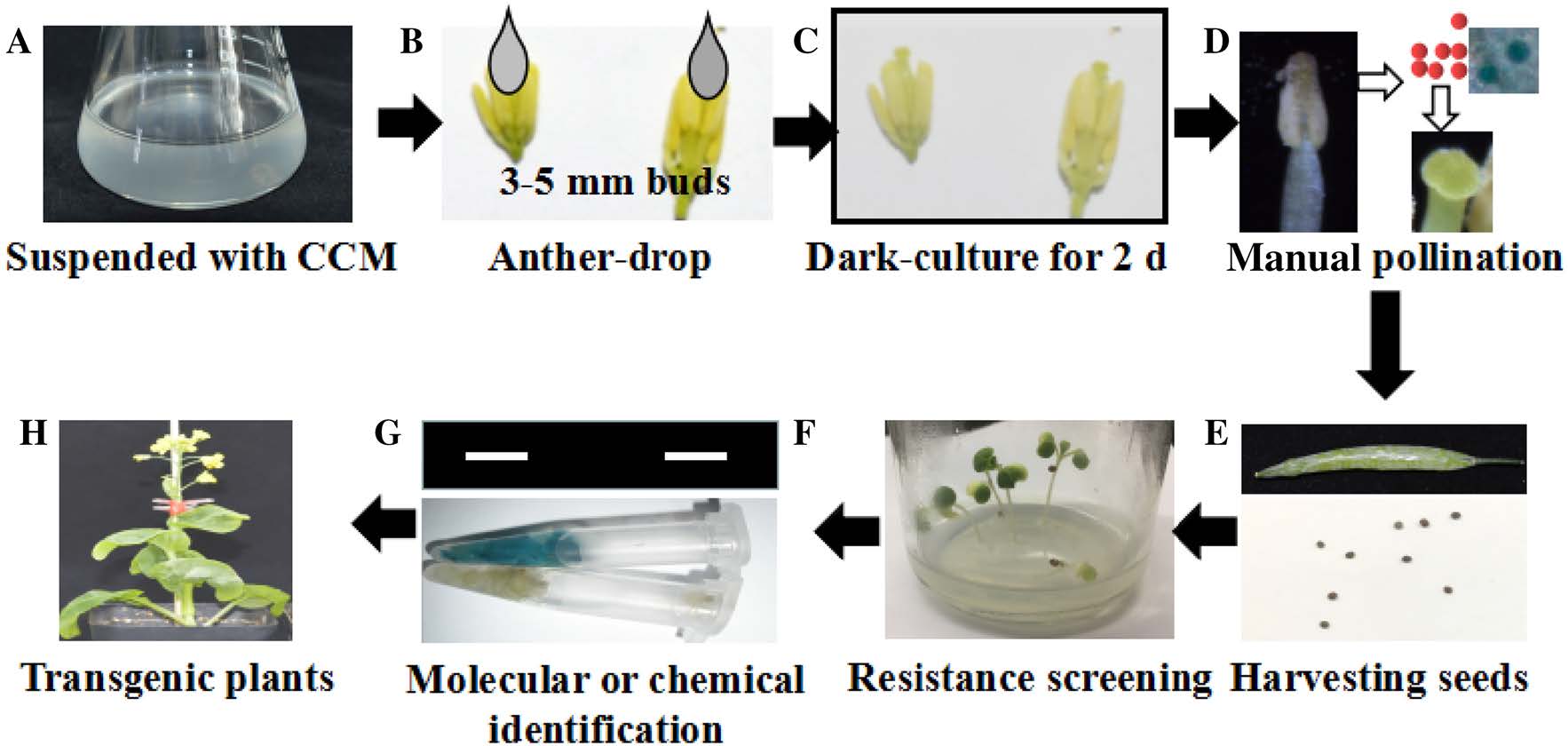Brassica campestris L., also known as rape, canola, is a cruciferous and Brassica plant with dark green stems and yellow flowers. Brassica campestris L. is rich in nutrients and has a high vitamin C content, it can be eaten when they are not blooming. After the flowers are withered, Brassica campestris L. can be used to squeeze oil, with an oil content of 35%-50%. Rapeseed oil is rich in fatty acids and a variety of vitamins. In addition, rapeseed oil can also be used to make margarine and artificial protein in the food industry. In order to further improve the nutritional value and industrial value of Brassica campestris L., reduce the cost of cultivation process, research on genetically modified Brassica campestris L. has become a hot field in recent years. Most genetic modification are aim to improve Brassica campestris L.’s disease resistance, insect resistance, herbicide resistance, salt tolerance, cold tolerance, storage tolerance, oil yield, etc.

Lifeasible provides one-stop services, covering all steps including experimental design, vector construction, plasmid transformation, positive transplant screening and characterization of transgenic Brassica campestris L. We offer Brassica campestris L. transformation using various genetic engineering technologies as follows:
Gene overexpression is a common technique for studying gene function. The development and utilization of gene overexpression has brought us many conveniences for studying gene function and improving the yield of target products. Through the quantitative overexpression of genes related to carotene, riboflavin, thiamine, rapeseed oil and other chemical components in Brassica campestris L., the production of specific compounds can be increased. We could help you overexpress many genes including herbicide-resistant glyphosate genes EPSPS, ALS, leaf variegated gene PDS3, low-phosphorus stress resistance gene BnPAP17, gene AT114 that affect fatty acid composition in Brassica campestris L., and aliphatic glucosinolate transport gene BnaGTR which related to resistance of biotic stress hazards, and many other genes related to important traits of Brassica campestris L.
RNAi technology is widely used in the field of gene editing, it is a phenomenon of specific gene silencing mediated by double-stranded RNA (dsRNA) and involved in specific enzymes. It blocks gene expression at the transcription level, post-transcriptional level, and translation level. Through RNAi technology, we can achieve silencing of multiple genes in Brassica campestris L.
Virus induced gene silencing (VIGS) is a genetic technology that inhibits the expression of endogenous genes in plants by inserting recombinant viruses into target gene segments, they can induce plant endogenous gene silencing and cause phenotypic changes, and then study the function of target genes based on phenotypic changes. The VIGS technology is a method of transient transformation and underlying molecular basis may be post-transcriptional gene silencing. Silencing and functional analysis of target genes in Brassica campestris L. through VIGS can help our customers save time and achieve valuable information for gene functional analysis. With wealth of experience in VIGS, our scientists in Lifeasible can provide you with customized protocol for VIGS in Brassica campestris L.
CRISPR gene knockout technology is currently the most widely used gene knockout technology, it provide us with a very powerful and convenient gene editing tool. As a leading company that has been deeply involved in the field of gene editing for many years, by CRISPR technology, we can knockout Brassica campestris L. genes in different ways, including frameshift mutations, multiple deletion of fragments, knockout of non-coding genes, knockout of multiple copies of genes, etc.
CRISPR system has strong scalability, and this scalability can be used to develop more useful gene editing tools. we have developed many methods that can improve gene knock-in efficiency and achieve precise editing of the Brassica campestris L. genome.
CRISPR Single base editing technology is a hot area of life science research today. As a company that has been cultivating gene editing technology for decades, Lifeasible could help you achieve the conversion from C to T or A to G in Brassica campestris L. using CBE and ABE, both of which rely on the fusion of dCas9 to a deaminase.
Sequence-specific control of gene expression on a genome-wide scale is an important approach for understanding gene functions and for engineering genetic regulatory systems. CRISPR Interference (CRISPRi) is a popular method to participate in the inhibition of gene expression. For the inhibition of Brassica campestris L. genes, we can provide a variety of solutions, including dCas9 binding to targeted DNA and realizing Inhibition of gene transcription through steric hindrance. In addition, gene knockdown can also be achieved by recruiting a fusion protein to the start site of gene transcription.
CRISPRa technology uses the powerful capabilities of Cas9 and sgRNA to fuse or recruit multiple proteins to enhance gene transcription. For Brassica campestris L. genes, we provide VPR technology, SAM technology and Suntag technology to allow the CRISPR system to carry more activation element and achieve a stronger activation effect after synergistic amplification.
The study of gene function has always been the core subject of biological research. The earliest genetic screening system established through forward genetics is very inefficient and has a huge workload. However, the reverse genetic screening system based on CRISPR technology can complete very low-cost mutation library construction work. The gene mutation library construction technology we provide for Brassica campestris L. including gene knockout library construction, gene knockdown library construction, and gene activation library construction. Moreover, single-cell sequencing is available for mutation screening.
DNA-free gene editing technology has received extensive attention from the industry in recent years. We provide DNA free Brassica campestris L. genome editing services, including transient expression of CRISPR/Cas9 plasmid DNA, in vitro transcription of CRISPR/Cas9, and pre-assembled ribonucleic acid composed of purified Cas9 protein and sgRNAs complex. These technologies can avoid the integration of foreign DNA and genome, and reduce off-target effects. In addition, compared with traditional techniques, these techniques can avoid the use of hybridization or backcrossing to isolate CRISPR/Cas9 chimeras, so they are cheaper and have shorter experimental cycles.
Genetic Transformation Process for Brassica campestris L.
Plant gene transformation technology is a basic technology for studying plant gene functions and obtaining excellent plant traits. So far, the most advanced and widely used method for the development of genetically modified Brassica campestris L. is Agrobacterium-mediated transformation. Briefly, the foreign target gene is transferred and integrated into pollen through Agrobacterium, and seeds are obtained by artificial pollination, and then genetically modified seeds are screened and identified to get transgenic plants.
 Figure 1. Procedure of transformation, (A) Agrobacterium were suspended with CCM, (B) Sepals and petalspeeled buds sized 3–5 mm were inoculated with Agrobacterium using pollen inoculation method, (C) Inoculated buds were darkly cultured for 2 days, (D) Transformed pollen grains were pollinated to the stigma with manual pollination, (E) Presumptive transgenic seeds were harvested, (F) Kan+ plants were screened, (G) Transgenic plants were identified using PCR and histochemical stain analyses, (H) Transgenic plants were obtained. (Guohu, et al. 2019)
Figure 1. Procedure of transformation, (A) Agrobacterium were suspended with CCM, (B) Sepals and petalspeeled buds sized 3–5 mm were inoculated with Agrobacterium using pollen inoculation method, (C) Inoculated buds were darkly cultured for 2 days, (D) Transformed pollen grains were pollinated to the stigma with manual pollination, (E) Presumptive transgenic seeds were harvested, (F) Kan+ plants were screened, (G) Transgenic plants were identified using PCR and histochemical stain analyses, (H) Transgenic plants were obtained. (Guohu, et al. 2019)
Lifeasible offers our customers with professional one-stop services, covering all steps including experimental design, vector construction, plasmid transformation, positive transplant screening and testing. Adapting to diverse purposes of different customers, we provide multiple Agrobacterium strains (C58, LBA4404, EHA105, GV2260, GV3101), as well as commercial and customized binary vectors with variant selectable markers (Kanamycin, Hygromycin, Phosphinothricin, G418, etc.) Experts at Lifeasible obtain comprehensive knowledge and years of experience to solve technical problems and challenges in Brassica campestris L. transformation. We can draw customized solution to help you research on a variety of Brassica campestris L. genes (Including herbicide-resistant glyphosate genes EPSPS, ALS, leaf variegated gene PDS3, low-phosphorus stress resistance gene BnPAP17, gene AT114 that affect fatty acid composition in Brassica campestris L., and aliphatic glucosinolate transport gene BnaGTR which related to resistance of biotic stress hazards, etc.), Our services guarantee the success of your project. For more information or any inquiry requirements, please contact Lifeasible.
Reference